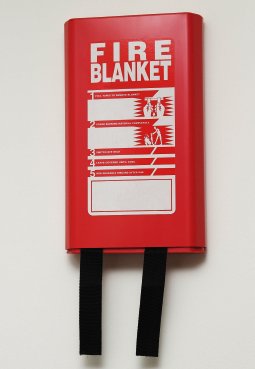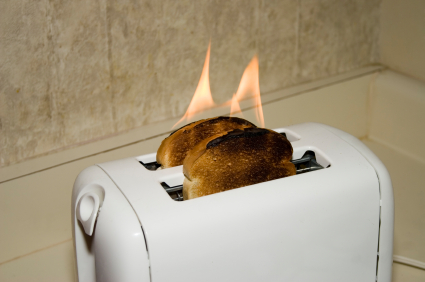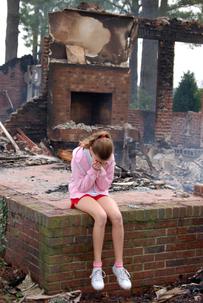A Fire Blanket is a Home Safety Essential
How to Use Fire Suppression to Save and Protect People and Property
As reported by the Centers for Disease Control, cooking is the leading cause of home fires. Fire blankets effectively address kitchen fires and other fire emergencies.
Smoking and holiday decorations are also responsible for a large percentage of home fires. In most cases, when a fire is trapped beneath a fire blanket before it has the opportunity to spread, lives and possessions can be saved.
What Is a Fire Blanket?
A fire blanket is a wool or synthetic blanket that has been specifically treated with fire retardants. Its operating premise is simple. Fires require oxygen to burn, and a fire blanket deprives the fire of oxygen and literally smothers it.
There are several types of fire blankets.
Wool fire blankets: These are general use blankets that can be utilized for
almost any type of fire. They look and feel like regular wool blankets with little stiffness.
Baby fire blankets: Small infant blankets treated with fire retardants are designed
to protect babies and toddlers. These blankets are lightweight and soft to the touch.
Kitchen fire blankets: These blankets are treated specifically for typical grease
and electrical fires in the kitchen.
Workplace fire blankets: Larger fire blankets are generally used in the workplace to
protect against chemical, oil or extreme heat fires.
EMS fire blankets: These heavier blankets are most often used by professional first responders. Their large size and hefty weight make them especially effective for wrapping around a burning person or for covering a person while escaping a fire.
Synthetic blankets and wool blankets are subjected to Thermal testing before being offered for sale to the public. A blanket's test rating can be obtained from the blanket's manufacturer.
Most fire blankets are reusable, moderately priced and washable (although repeated washings will eventually reduce fire retardant saturation.)
Using an Emergency Blanket
Unlike a fire extinguisher that requires some skill to operate effectively, a fire blanket is easy to use. Just unfolding and placing it over the fire, as centered as possible, is all that's required.
The single most crucial element of using the fire blanket is getting full coverage
of the fire, and if the fire is fueled by gas or electricity, remembering to cut off the fuel
source after the blanket is applied is important. Fire blankets can halt a fire in its tracks
if properly employed. Keeping flames from spreading is critical to containing a small
fire before it reaches the ceiling and exploits the opportunity to become a large,
uncontrollable one.
If it is a person involved in fire, a fire blanket can be especial
valuable. Throwing a blanket over a person who is burning, the
getting them to the ground, will snuff the fire faster than the stop, drop
and roll method alone. Fire blankets also offer protection to
those evacuating a burning building.
A fire blanket should not be removed from the fire source for at least
a half an hour, and caution should be taken when touching it after a fire.
Fire resistant gloves are an ideal complement to a fire blanket.
Home Safety and Fire Protection
Ideally, homes should maintain a fire blanket in every room in the house. Bags and wall-mounted cabinets that make it ready at a second's notice are available for housing the blanket. These can be mounted inside cupboard doors or in closets or garages.
In kitchens, the blanket should not be stored too close to the stove or electrical appliances where fires are most likely to erupt.
Fire blankets are effective fire fighting tools, but they should be just one component of comprehensive home fire safety. Smoke detectors, fire extinguishers, escape ladders and fireproof storage units are all important elements of protecting lives and valuables.
Fire Fighting Sense
If a fire is too deep, too large or already too advanced, a fire blanket alone may not extinguish it. No matter what fire fighting method is used, making sure an escape route is available is critical when attempting to fight any minor fire.
Evacuating people and pets, calling the fire department, and remaining calm are all necessary components when facing a fire emergency. Taking the time to understand which fire extinguisher works on which fire, how and when to use the extinguisher or how to cover a fire with a fire blanket, before an emergency has arisen, offers a far better opportunity for safe resolution.
Fire control begins with study, practice and planning. A fire blanket can be a life and property savior, but it is only one tool in a fire-fighting arsenal.
Fires are fast. They can grow and spread rapidly and should never be underestimated. "Safety first" should be every person's survival creed.
Sources:
Fraser Coast Chronicle
Centers for Disease Control (CDC)
Total Home Security.com
FEMA
US Fire Administration (USFA)
Home Security Guru.com
Fire Blankets Can Be Wool or Synthetic
Fire Blankets Can Stop Kitchen Fires
Fire Blankets Can Lessen Burns
Fire Blankets Can Save Lives and Property
Fire Blankets Can Help Prevent Catastrophic Fire Spread
Timeless
Life and Living
with Tricia Spencer
The copyright of the article A Fire Blanket is a Home Safety Essential is
owned by its author, Tricia Spencer.
Permission to republish any part of the article in print or online
must be granted by the author in writing.













